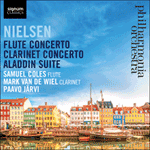
Welcome to Hyperion Records, an independent British classical label devoted to presenting high-quality recordings of music of all styles and from all periods from the twelfth century to the twenty-first.
Hyperion offers both CDs, and downloads in a number of formats. The site is also available in several languages.
Please use the dropdown buttons to set your preferred options, or use the checkbox to accept the defaults.

| Mark van de Wiel (clarinet), Philharmonia Orchestra, Paavo Järvi (conductor)» More |
 RECORDING
RECORDING PERFORMANCE
PERFORMANCENielsen started work on the concerto while on a skiing trip with his sculptress wife Anne Marie in Norway. The composer had been ordered to rest by doctors following ongoing heart problems, but still managed to break two ribs on the slopes. Eventually Anne Marie continued on to Carrara in Italy to resume work on her latest project while Nielsen travelled to the summerhouse in Humlebæk, about 40km north of Copenhagen, which belonged to his friend and former pupil Carl Johan Michaelsen. From there, Nielsen wrote to another former pupil Nancy Dalberg (who had previously help him on the score for Aladdin): ‘I actually have no idea how it will sound’ the composer said of the new concerto; ‘Maybe it won’t sound good, but I will not compose music if I always have to compose in the same manner.’
Sure enough, the Clarinet Concerto ruffled feathers. On 14 September 1928, Oxenvad and a group of 22 musicians gave a private run-through of the piece in the drawing room of the summerhouse. Nielsen’s son-in-law Emil Telmányi conducted, describing the piece as ‘music from another planet.’ Critics in Copenhagen were cool when the piece was presented there on 11 October. Some days later, after its Swedish première in Stockholm, the critic Olag Petersen- Berger described the piece as ‘absolutely the worst thing that this slightly too obviously experimental and provocatively sidestepping Dane has yet put together.’
Nielsen would have been delighted. He later claimed the poor reviews proved ‘that one is not quite sacrosanct yet, that one is still alive and has hope and possibilities for development.’ In his determination to reveal everything about both Oxenvad and the clarinet—an instrument he described as ‘at once warm hearted, and completely hysterical, gentle as balm and screaming as a streetcar on poorly lubricated rails’—Nielsen had delivered what would soon be recognised as the most important clarinet concerto of the 20th century. Where previous scores by the composer had been invested with a sure sense of continuity, this one appeared both elusive and episodic—intentionally so. Its hints at atonality (the jettisoning of traditional harmonic process) would have sounded with a sharp modernist edge in 1928; the concerto as a whole can still sound raw, harsh and intense today.
But for all that, the concerto was built along Classical structural principles even though its ‘movements’ lead into one another with no break. The work begins when the orchestra states a simple theme as a sort of fugal nursery rhyme into which the soloist duly enters before taking on some of the wild and troll-like characteristics Nielsen claimed he saw in it. After teasing and irritating the orchestra, the clarinet encounters a wily snare drum (the composer specified it should be a small, bright drum). This instrument, rather troll-like itself, provokes and eggs-on whenever it can. Its principal target is the soloist—specifically, whenever the clarinet appears to drift into reflective or melancholy mood.
Some way into the first movement the clarinet indulges in its own choleric cadenza, which appears to provoke the orchestra into the hurtling passages that precede the Poco adagio section. This opens with a yearning horn solo whose strange gait stems from the fact that it is written in two keys: the horn in C major and the two accompanying bassoons in E major. The horn soon makes way for the soloist, who continues in the same vein and attempts to exert the same calming influence on the entire movement, despite yelping strings and the everdestabilising snare drum. When the energy levels have been sufficiently raised, the clarinet has no choice but to enter the fray.
A short cadenza then leads to the Allegro finale, in which the horn again introduces the movement’s initial theme over lolling strings. The clarinet arrives on a version of that horn theme, and continues in songful vein until the orchestra (encouraged by the snare drum) gets hooked on a flowing idea, high strings suddenly sounding a manic alarm. That leads into the soloist’s third cadenza and then the Adagio section in which, as always, the clarinet is shaken from its pensive repose by the snare drum.
From here it’s a bumpy ride—plenty of song-like passages interrupted by the clarinet japes (often in the form of flowery, virtuoso flourishes) or by the trolling snare drum—until the clarinet hesitantly circles around an F and eventually comes to rest on it, surrounded by a halo of strings playing on shimmering harmonics. It’s unlike Nielsen to end on the same key (and, indeed, note) that he began on; could the composer, ever more aware of his heart condition and speaking of ‘changing attitudes’ since his skiing trip to Norway (complete with accident), have caught a glimpse of his own mortality?
from notes by Andrew Mellor © 2016
 Nielsen: Flute & Clarinet Concertos Nielsen: Flute & Clarinet ConcertosThe Philharmonia Orchestra and Paavo Järvi perform two of Nielsen's characteristically fiery concertos, orchestral principals Samuel Coles (flute) and Mark van de Wiel (clarinet) stepping up as the intrepid soloists.» More |

